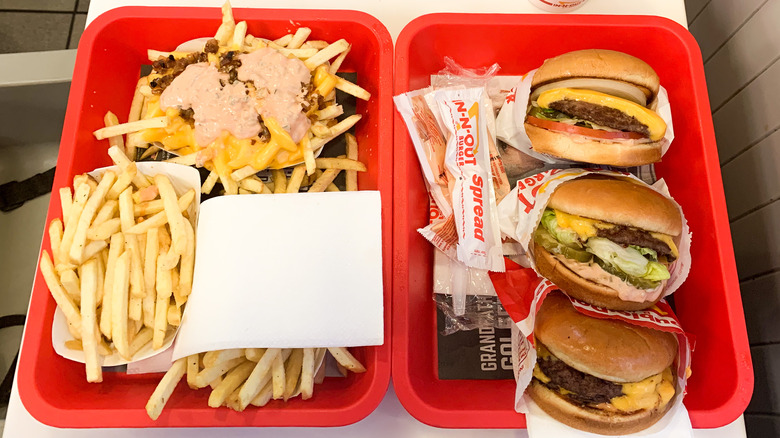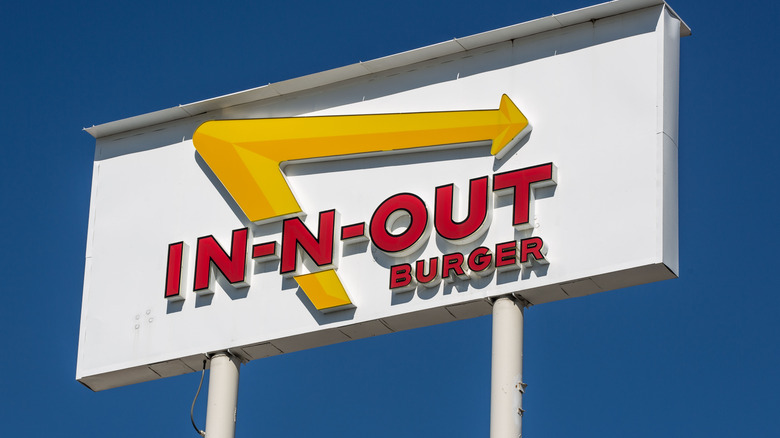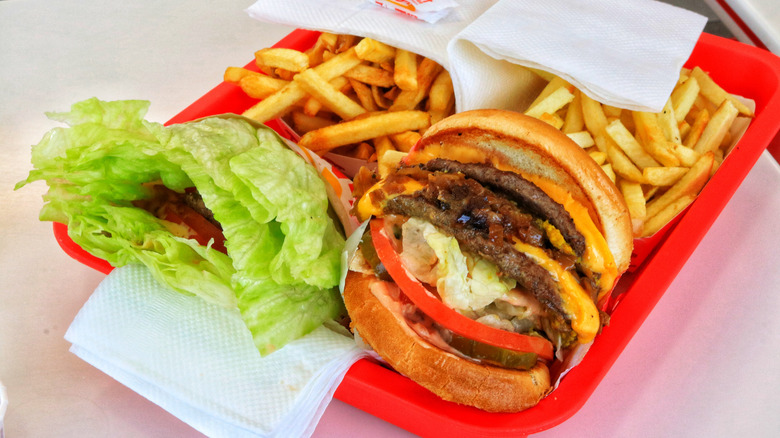Why In-N-Out Burger Probably Won't Be Coming To Your City
It is one of the most popular burger joints in the U.S., but if you live on the East Coast, you'll only hear about it online as some sort of mythical fast food legend. Operating for more than 70 years (via the chain's website), In-N-Out has been the talk of West Coast fast food fanatics — and even Anthony Bourdain gave it a glowing review (via YouTube). In-N-Out is also legendary for its high-quality burgers and its expansive "secret menu," with options ranging from animal-style burgers, well-done fries, and Neapolitan milkshakes, as Serious Eats points out.
Unlike other companies in the world of Big Burger, however, In-N-Out isn't a sprawling franchise offering PlayPlaces, mascots, revamped chicken sandwiches, or trendy marketing schemes — far from it, in fact. In-N-Out can only be found in California, Nevada, Arizona, Oregon, Colorado, Utah, and Texas with over 300 locations spread out among them. That's a shockingly low number compared to the staggering 18,332 McDonald's (via FinancesOnline) or even the 7,257 Burger Kings (via ScrapeHero) that dot the United States.
But why exactly keep themselves so limited? If they are as great as everyone says, the company should be scrambling to put up In-N-Out's from Maine to California, right? Is it some intense West Coast pride? A fear of pushback by larger fast food giants? The answer to this question combines a company promise, a taste for quality, and a rather unique method on cultivating popularity.
In-N-Out wants to keep things simple
There's actually a fair amount of explanations as to why the cult classic burger joint won't expand beyond the West Coast. The first explanation is due to In-N-Out's strict policy of serving all food fresh, a policy that is held with such regard that no freezers, microwaves, or other culinary shortcuts can be found in any In-N-Out (via the brand's website). Since the meat can't be shipped frozen across country without risk of spoiling, all In-N-Outs must be located within 300 miles of their distribution facilities, according to InsideHook, which only adds to the allure of getting a fresh, juicy In-N-Out burger.
The second explanation borrows from the idea that the more exclusive something is, the more people will want it. Exclusivity in marketing isn't an uncommon practice (via RetailInsider), and In-N-Out uses its selectiveness to craft that mythical air around it as a humble, yet delicious, burger joint, as The Lemonade Stand points out. After all, isn't there something so rewarding about getting what few can only dream of?
The third reason ties back to the company promise of "no franchising." To franchise, the company would ultimately be "selling out," changing everything that is beloved about the company. According to Lynsi Snyder, the president of In-N-Out, that doesn't seem to be too likely in the future. "It's not about the money for us," she said in an interview with Forbes. "Unless God sends a lightning bolt down and changes my heart miraculously, I would not ever sell."
How freshness comes first at In-N-Out
In-N-Out has gained a solid reputation because it lacks any sort of stereotypical fast food "shortcuts," such as freezers, heat lamps, or microwaves. Such a concept may sound incredibly strange in today's modern restaurant, where McDonald's fries are warmed under powerful heat lamps and rumors abound of Olive Garden microwaving food (via Redbook). It is because of this that In-N-Out can never be too far from any of its shipping facilities, lest they run the risk of the meat going bad. That much we know, but just how deep does the iconic burger joint's devotion to fresh food go?
According to In-N-Out, its burgers are made with fresh chuck steak, which is de-boned and ground into those crumbly pink pebbles of beef to be formed into patties, all done by a team of In-N-Out associates. Its close proximity to its facilities allows them to control each step of the process to ensure quality and freshness. But its pride doesn't stop at hand-made beef patties: Every ingredient boasts a sign of In-N-Out's commitment to high standards. The lettuce is hand-leafed, the American cheese is real, the fries are farm-to-store and fresh-cut in the building, and the shakes are made with real ice cream. It seems that, in exchange for a coast-to-coast In-N-Out empire, the company sacrificed it all to ensure commitment to its values, even if it meant walking away from joining the ranks of McDonald's or Wendy's in scale.
And perhaps that's just the way that In-N-Out Burger likes it.


